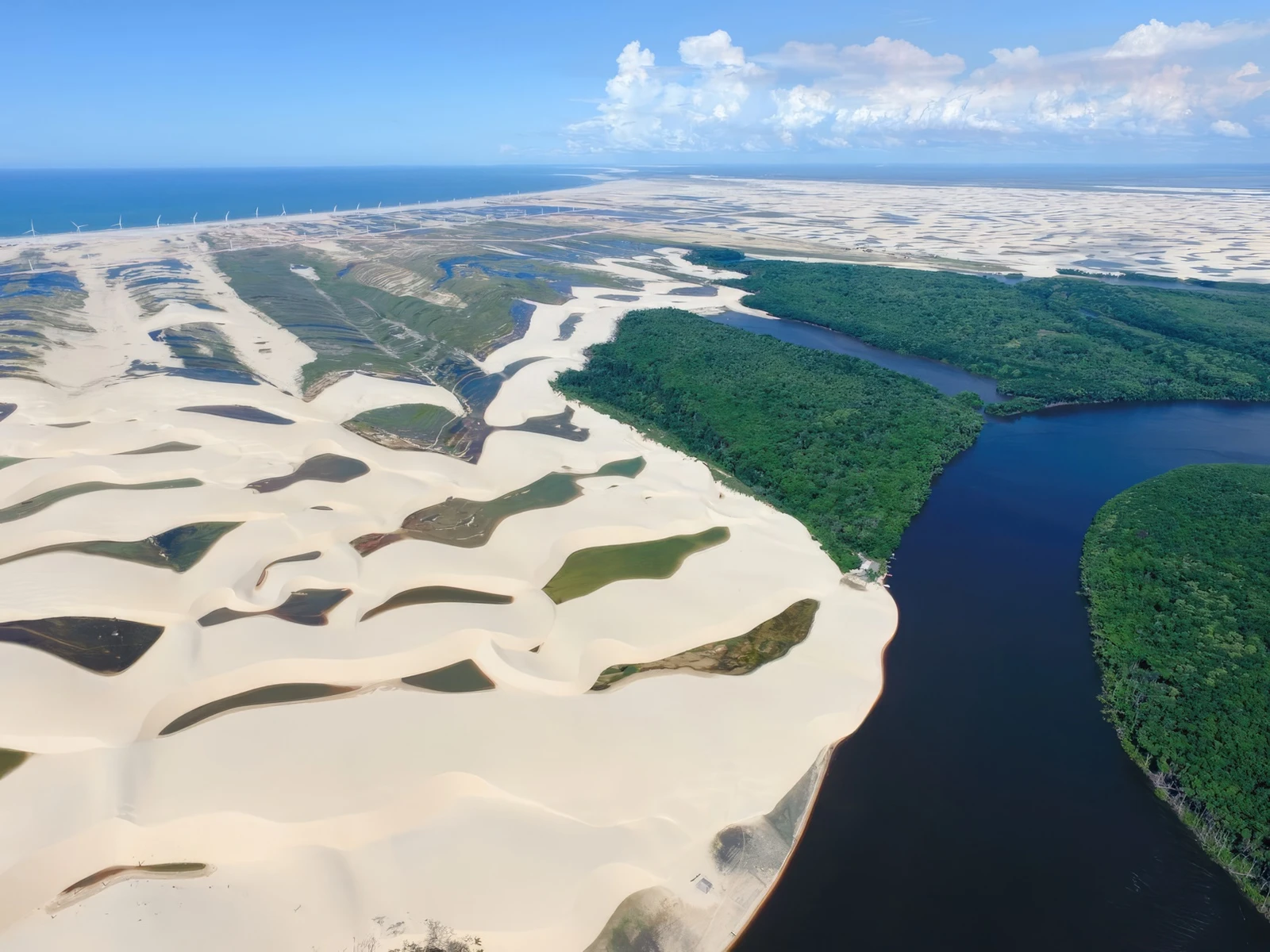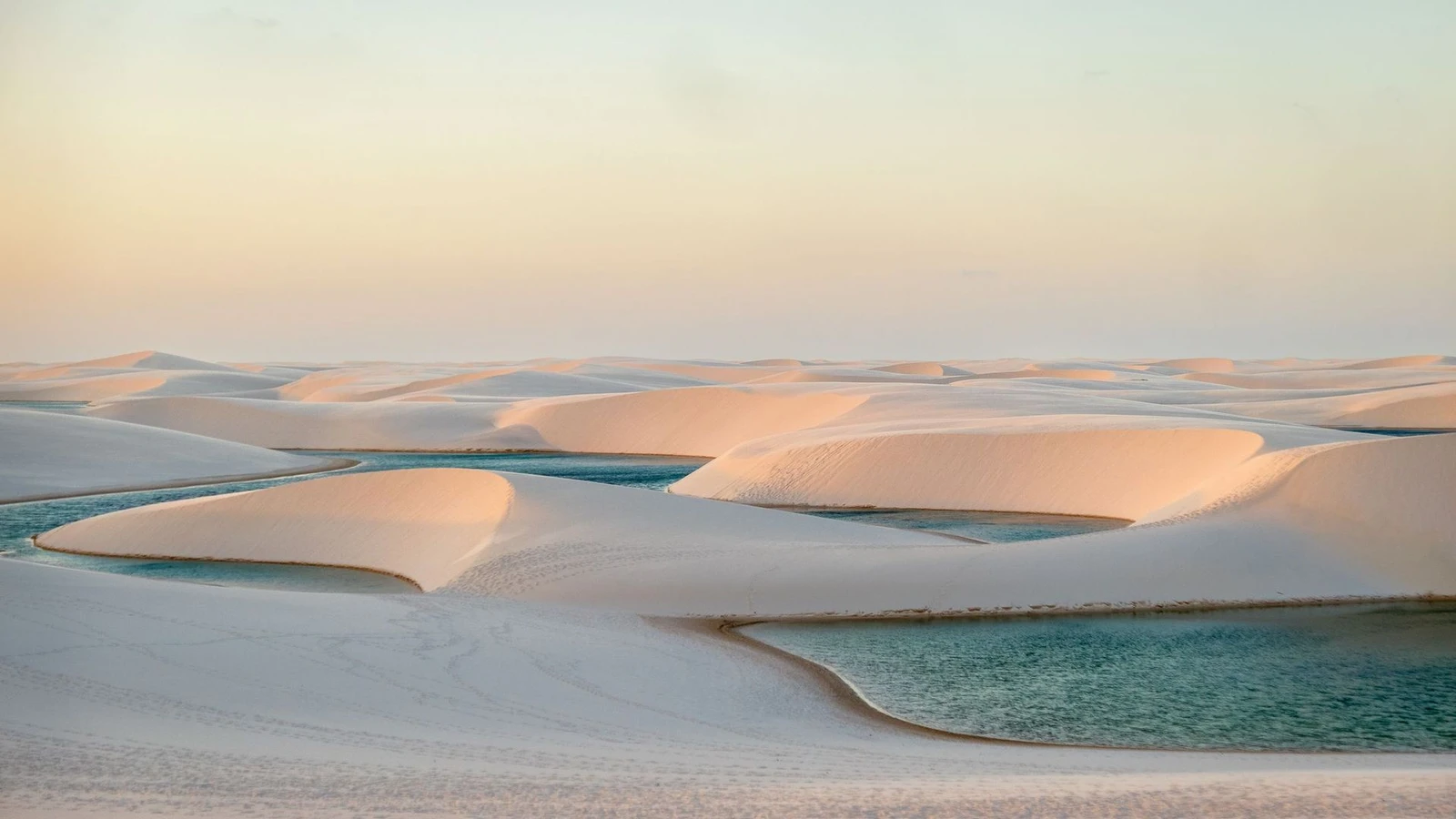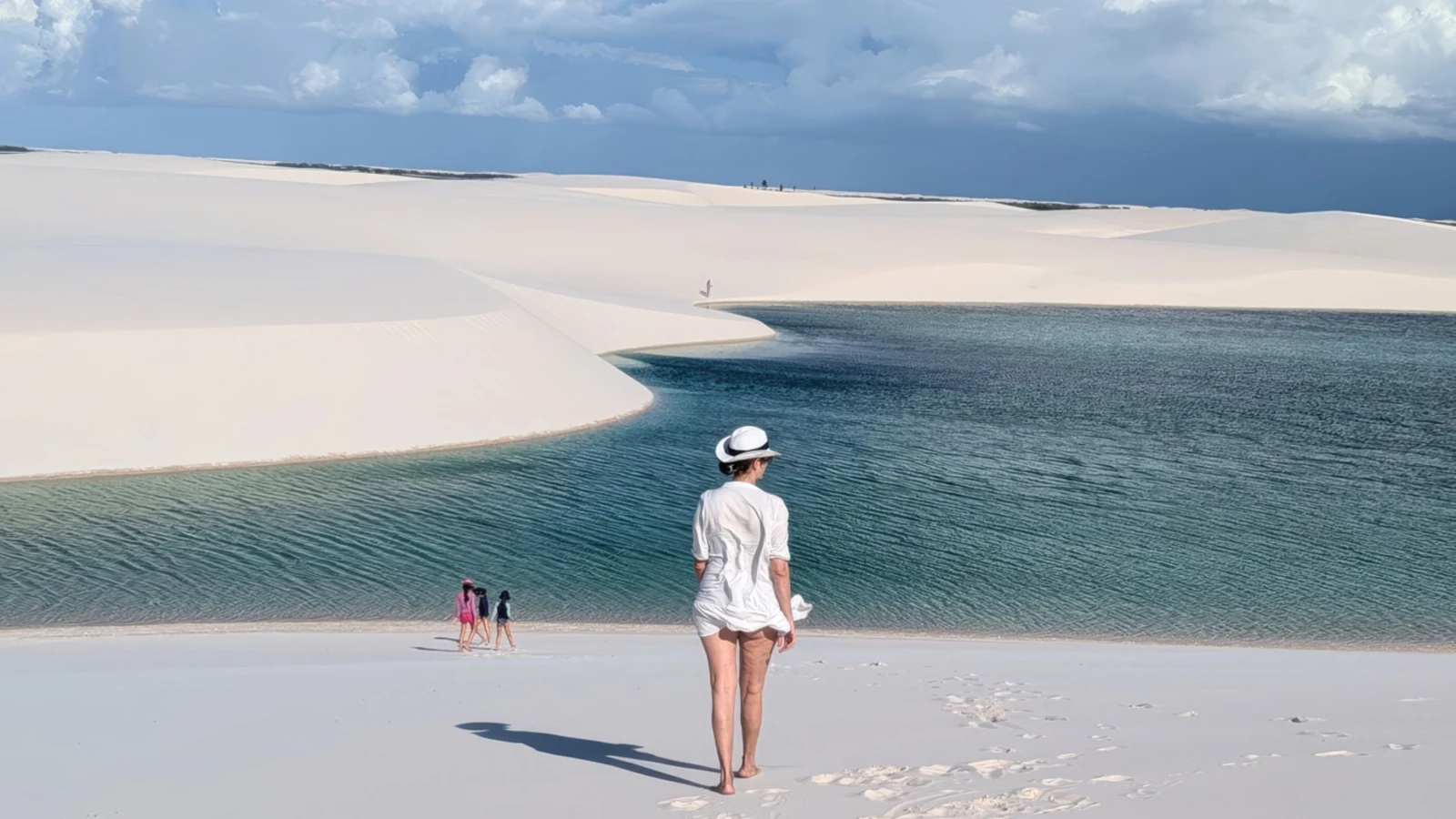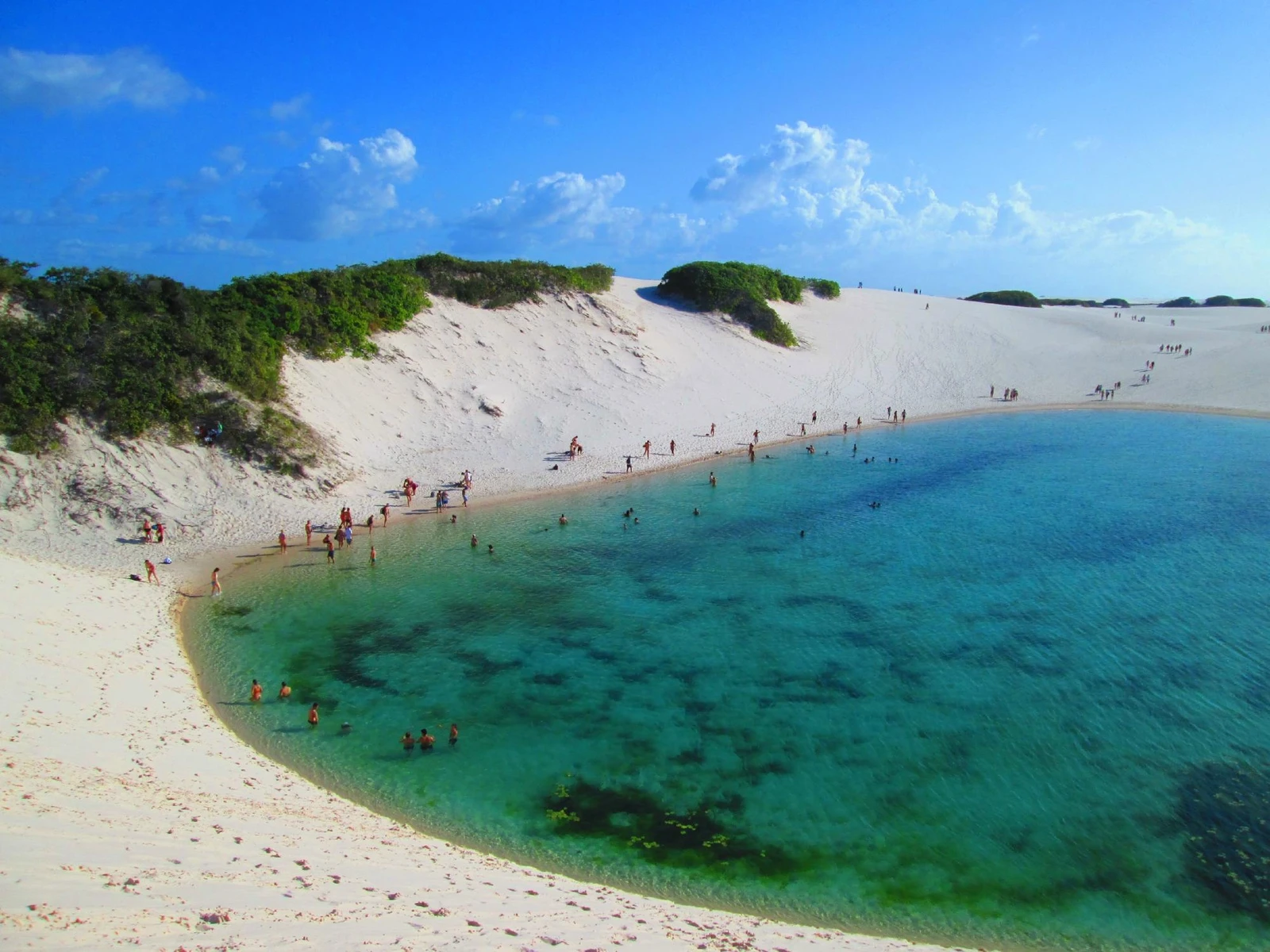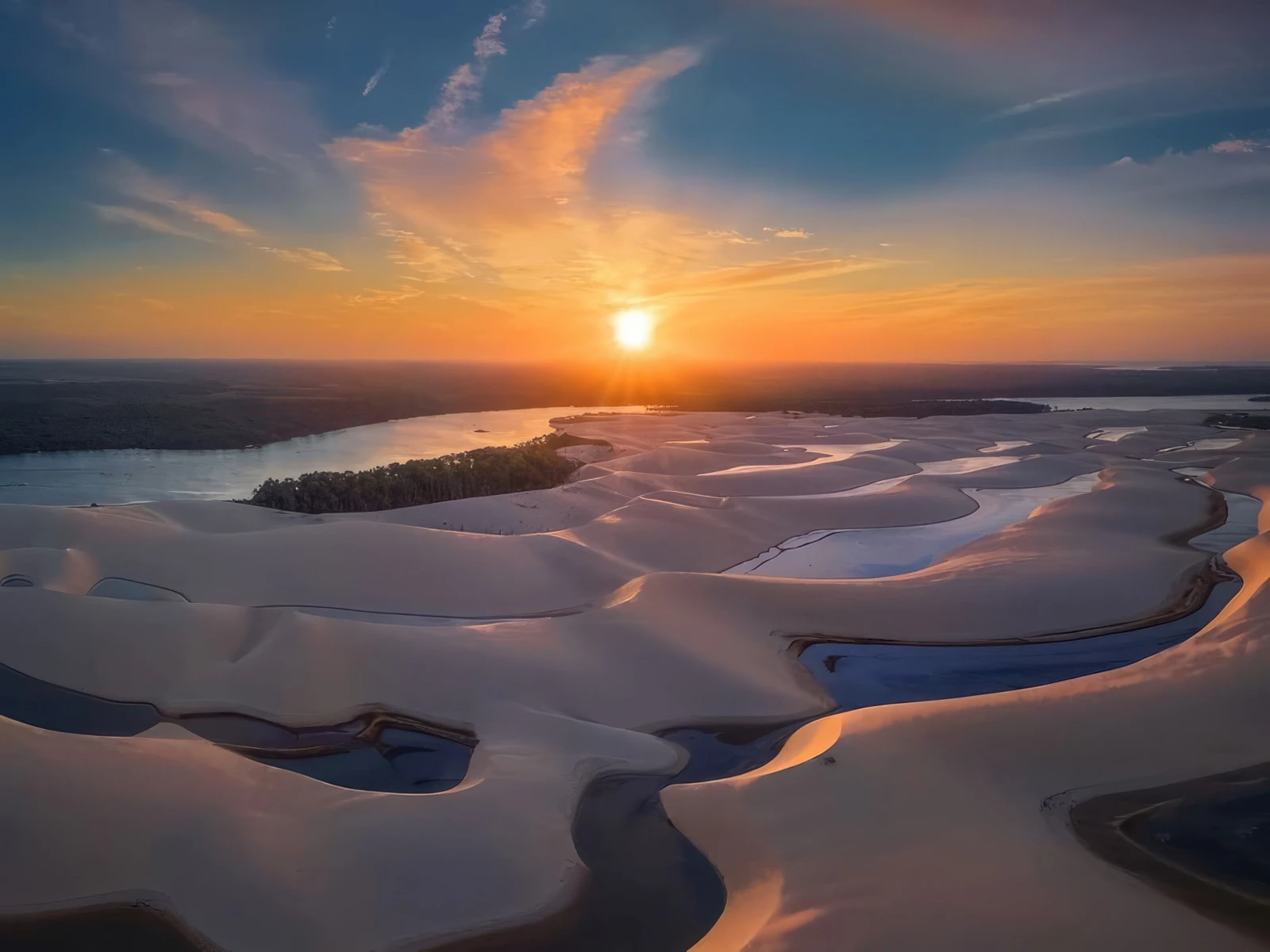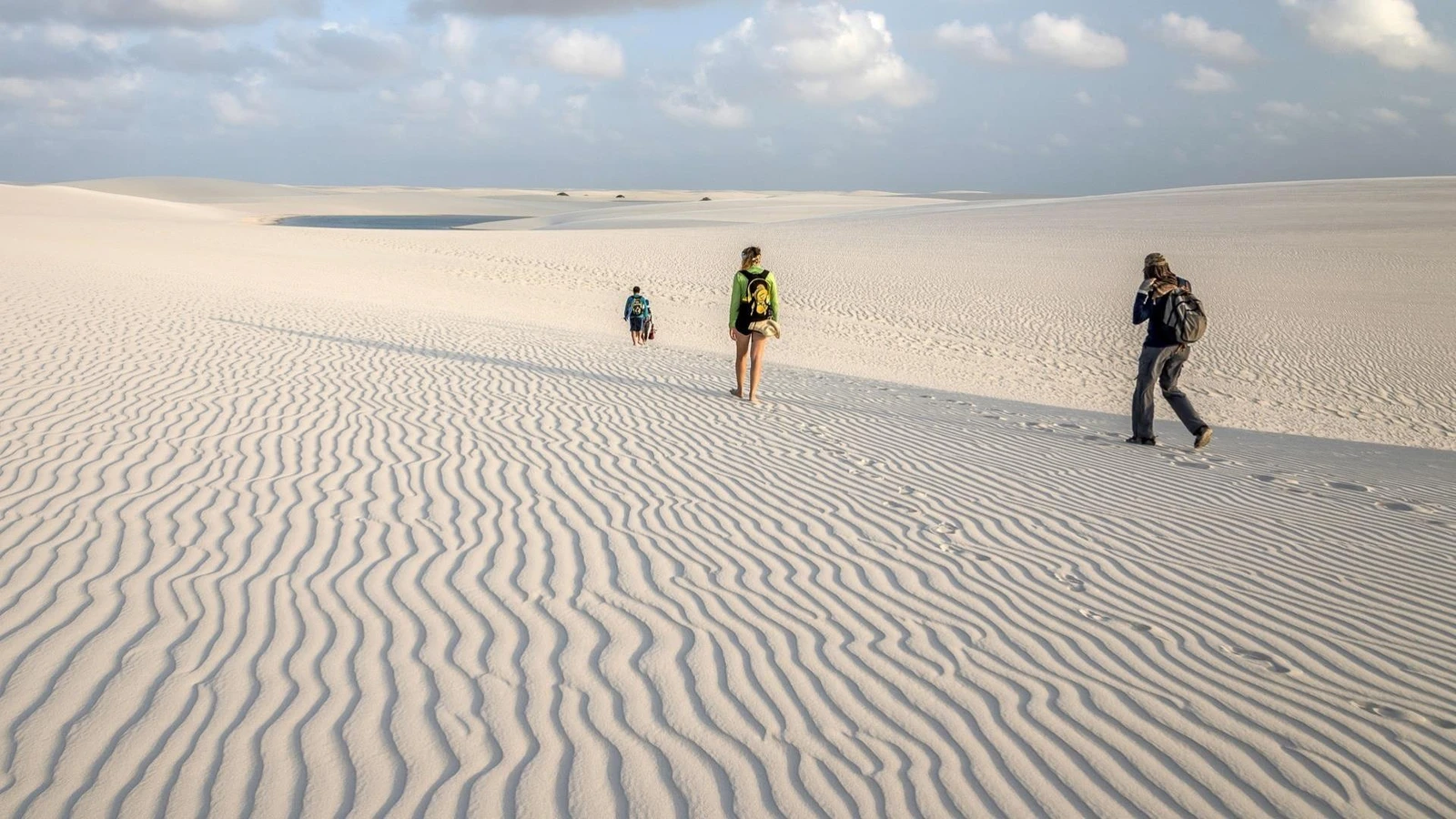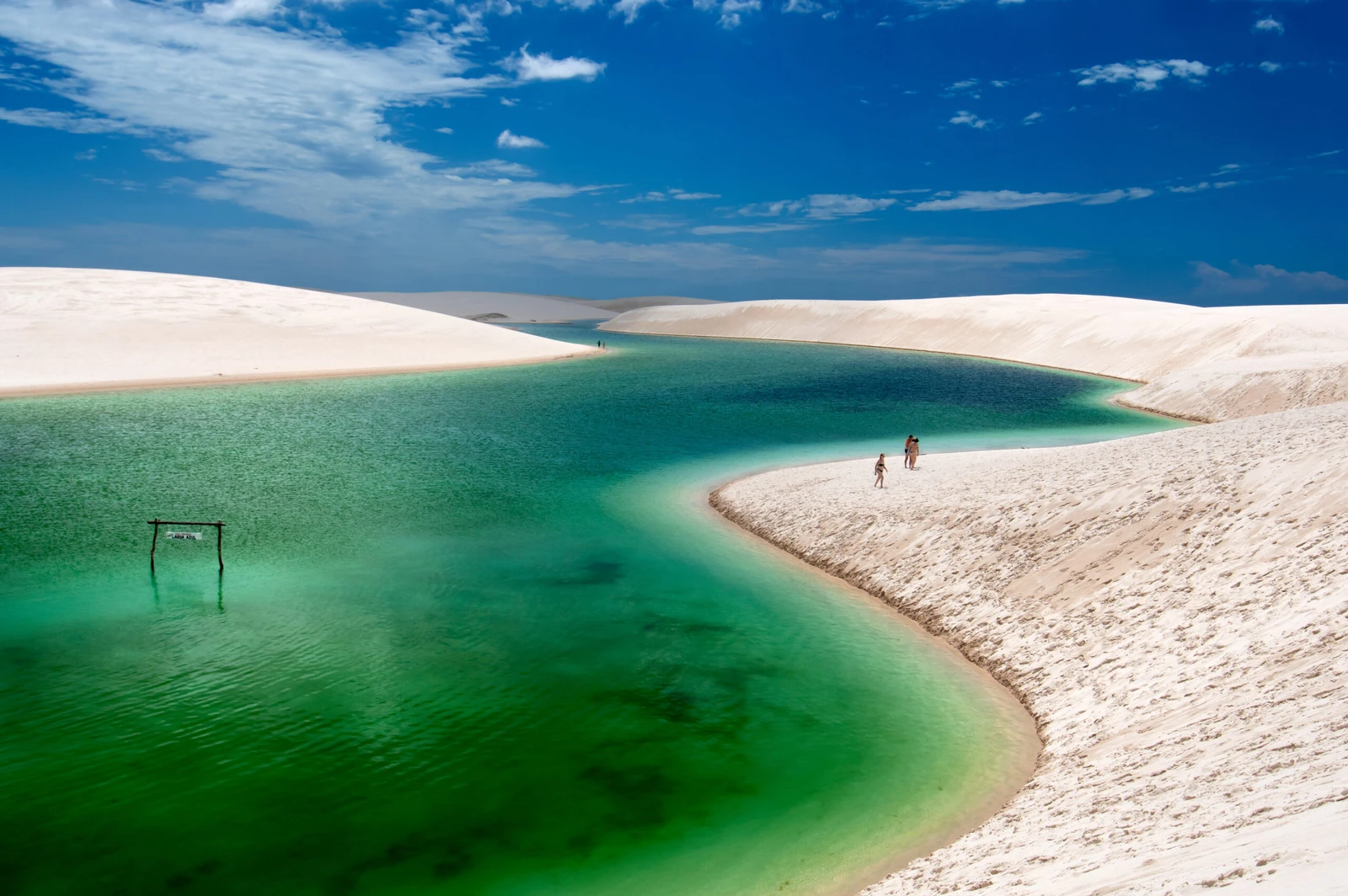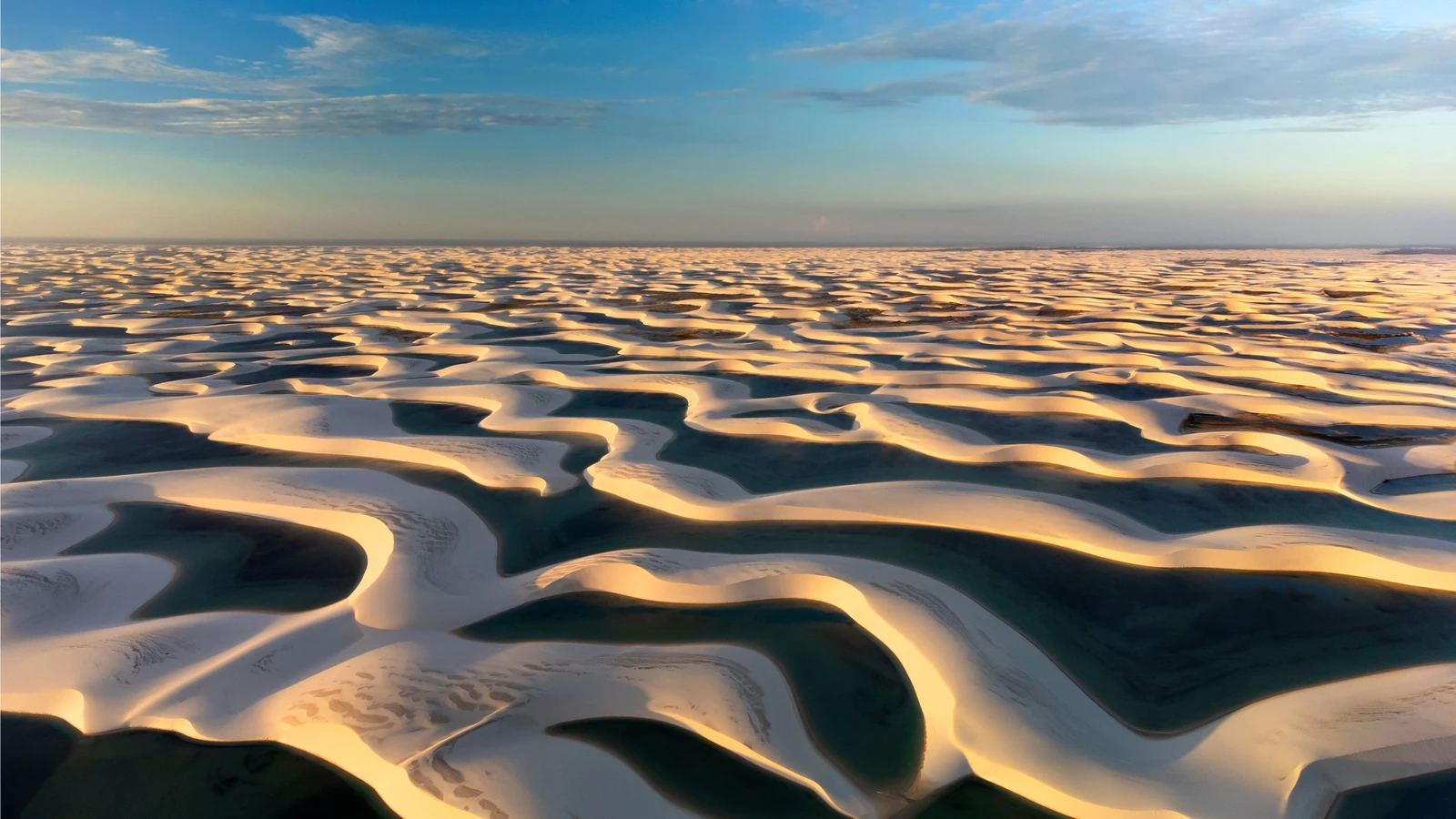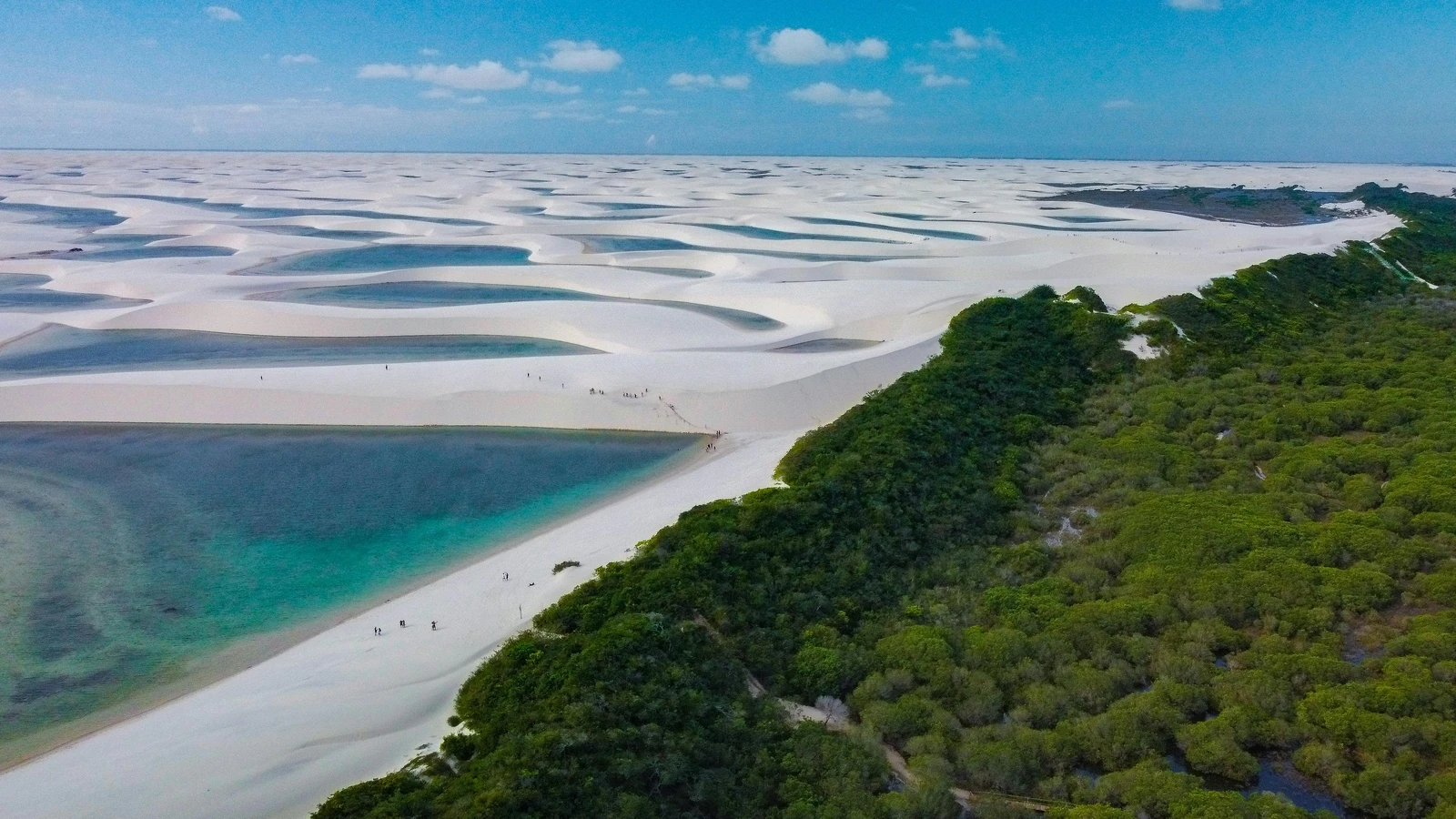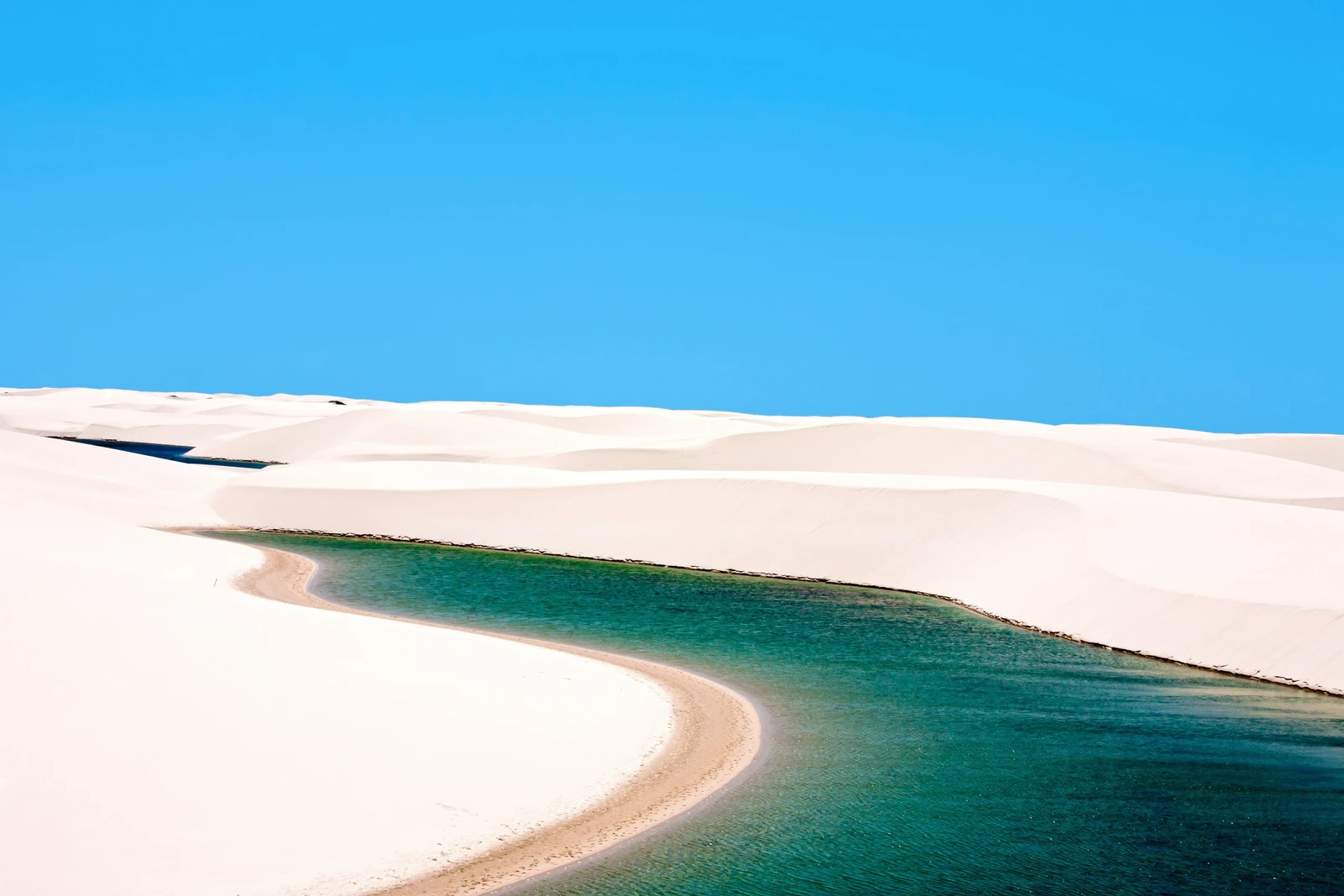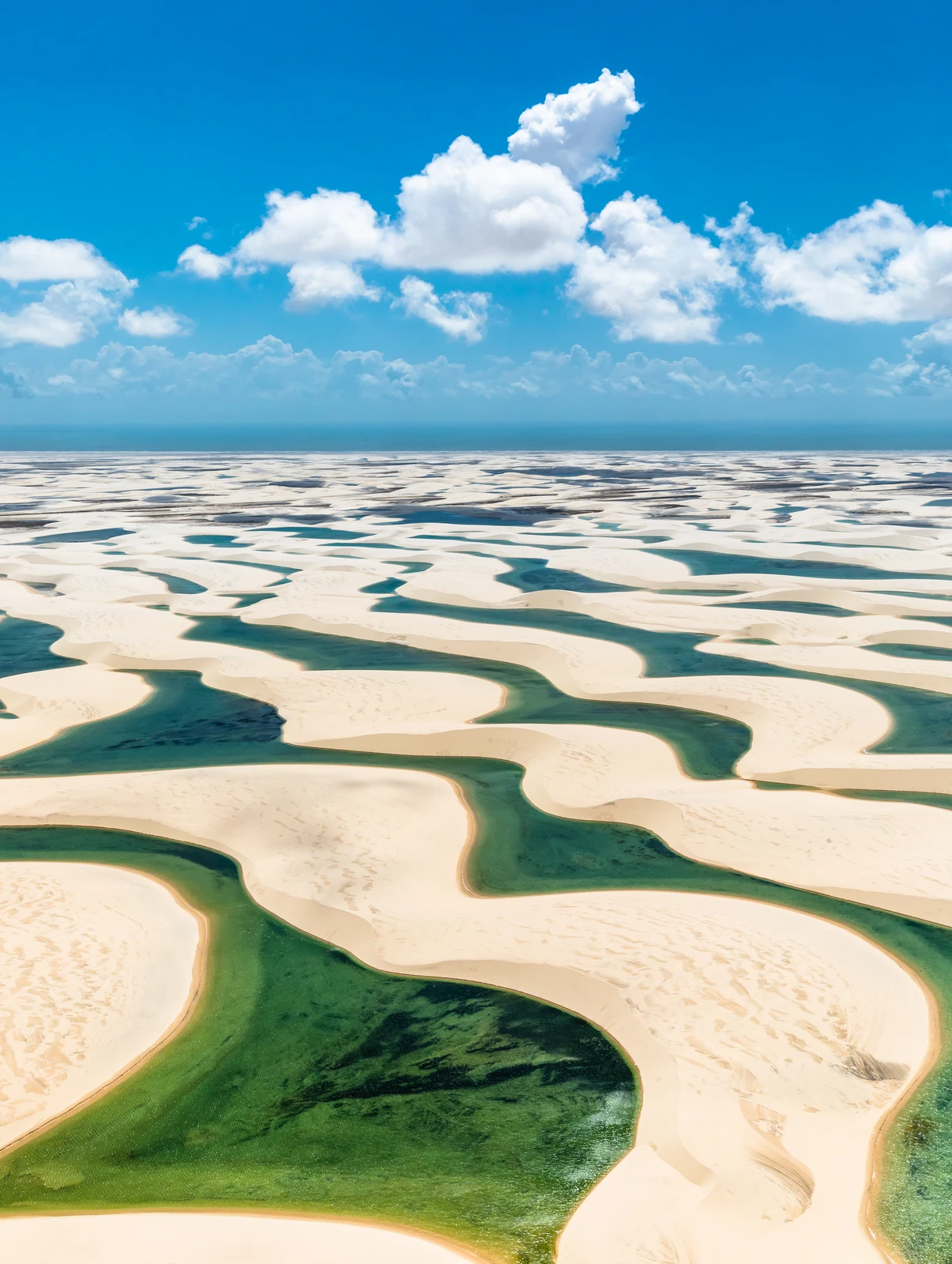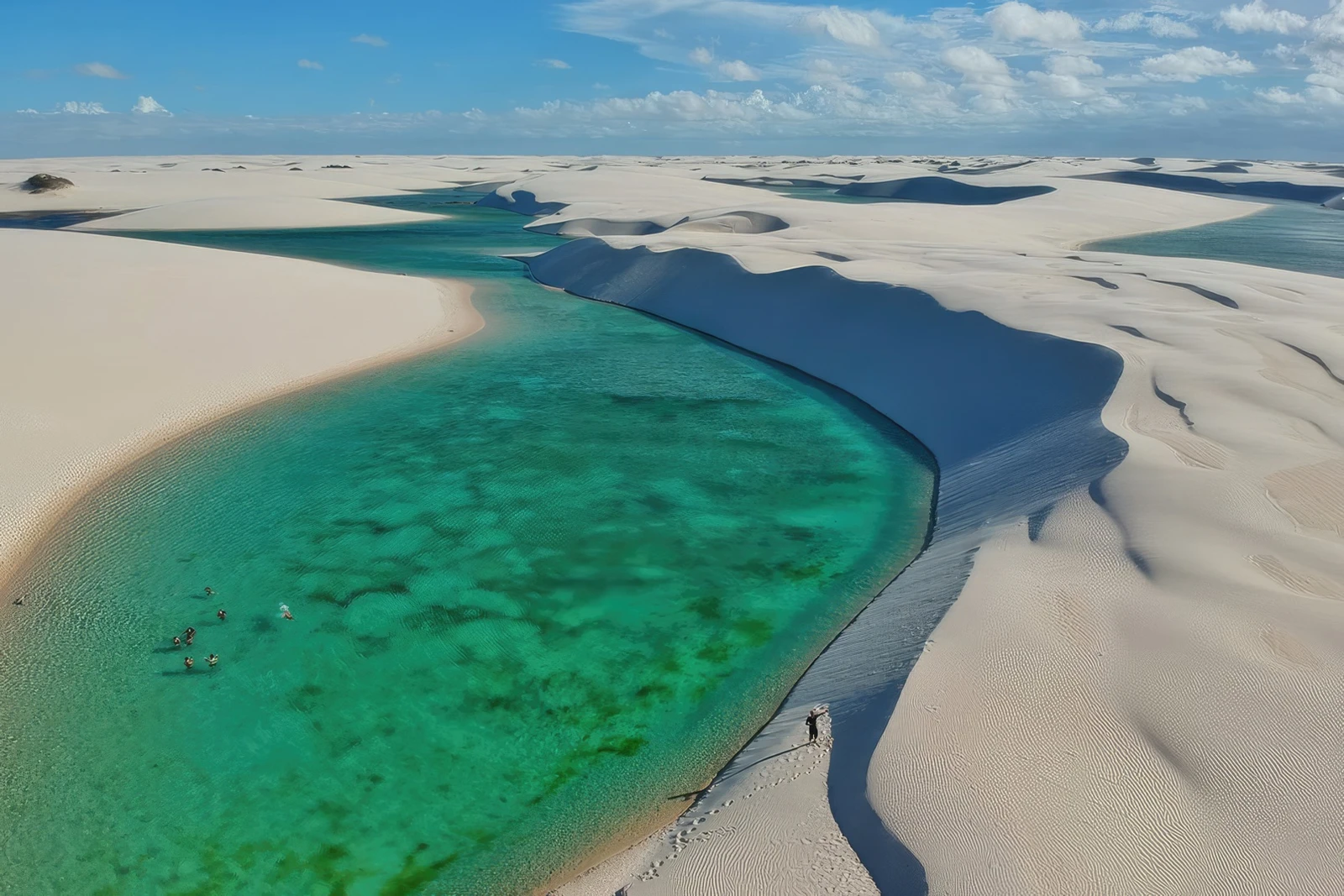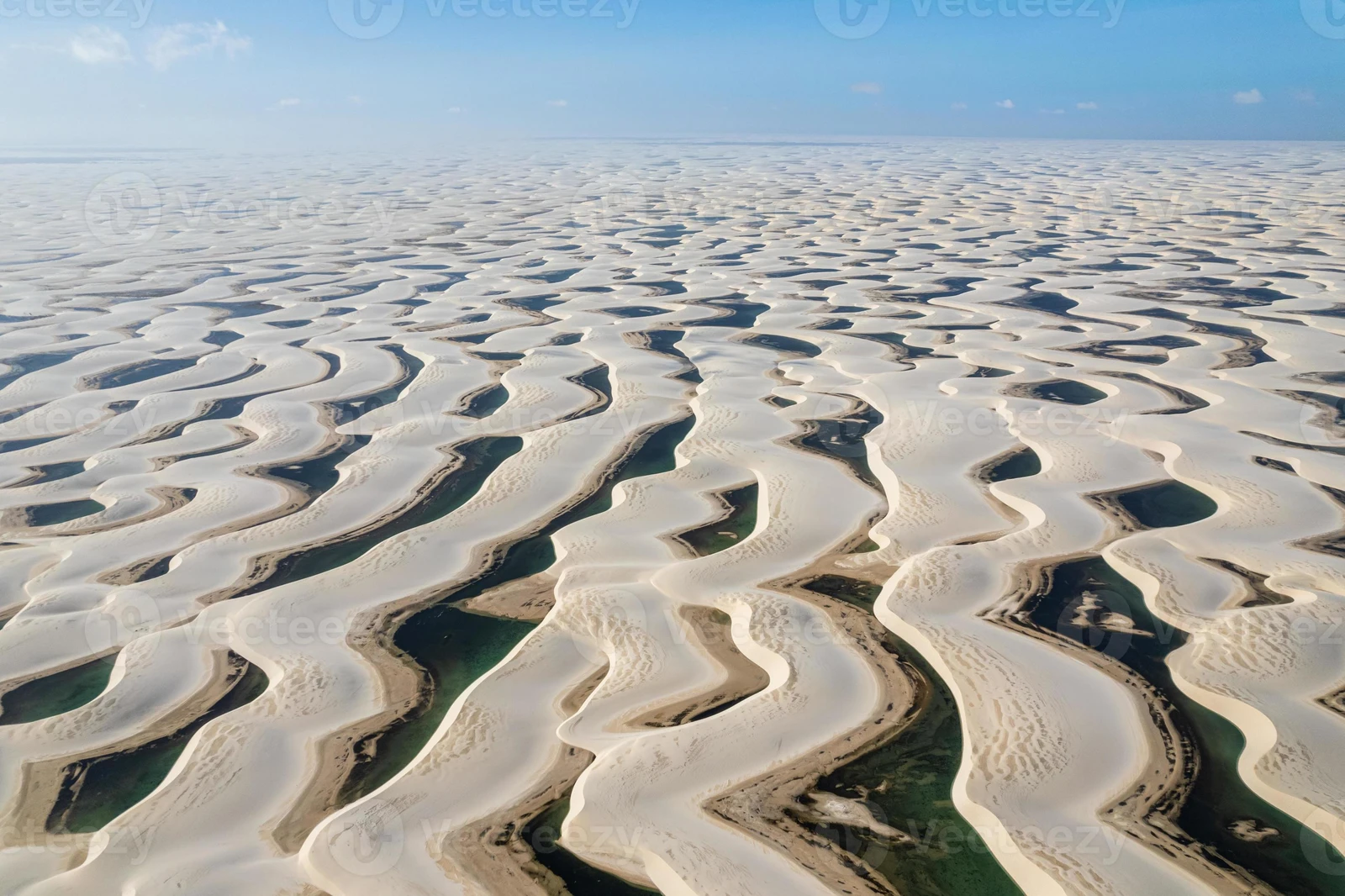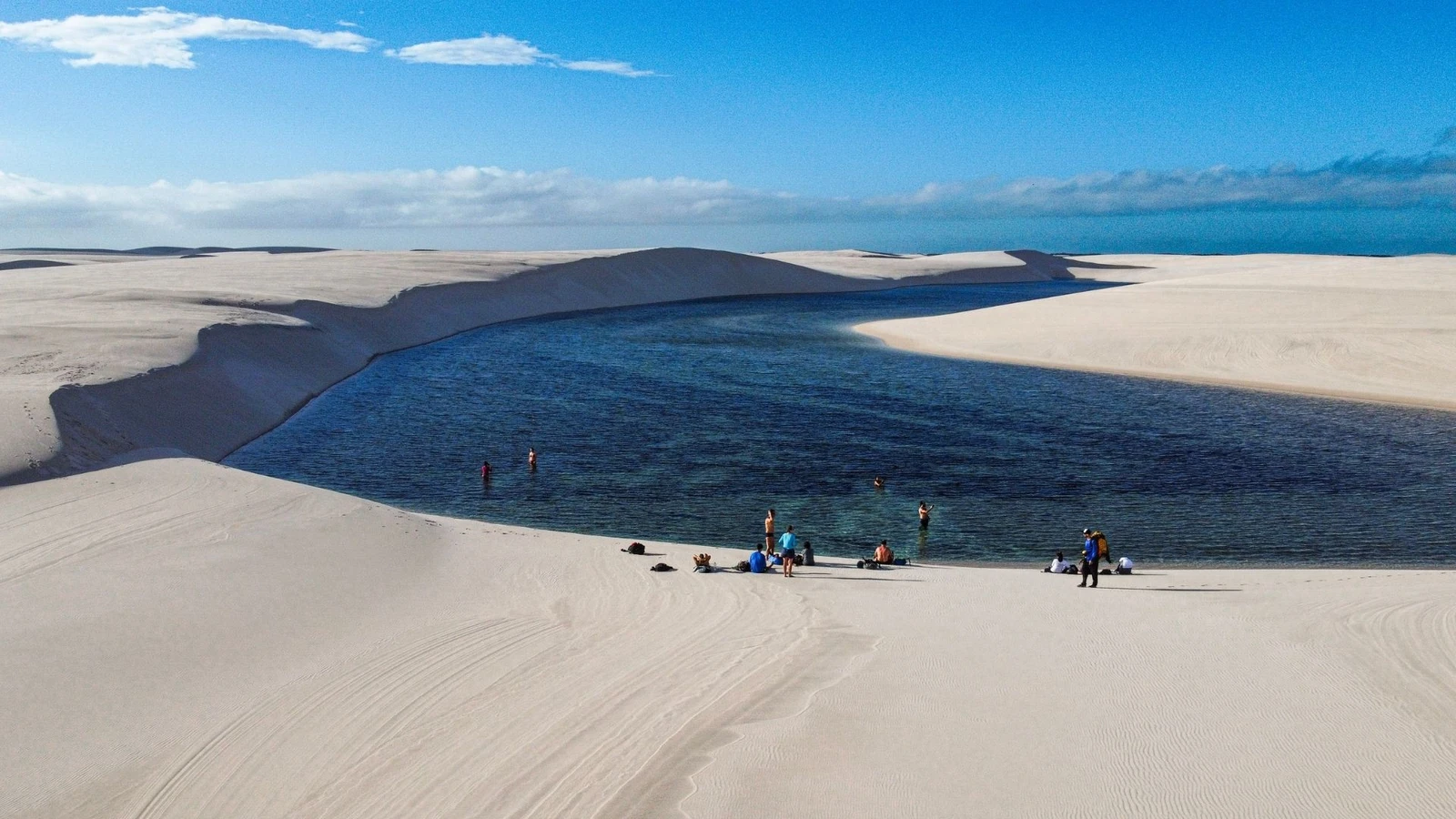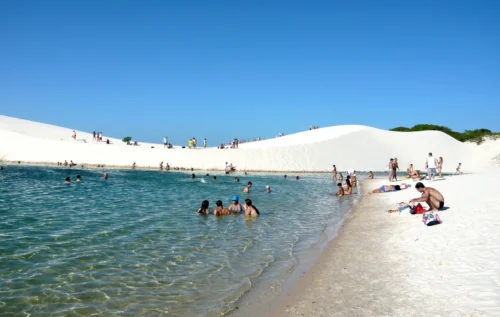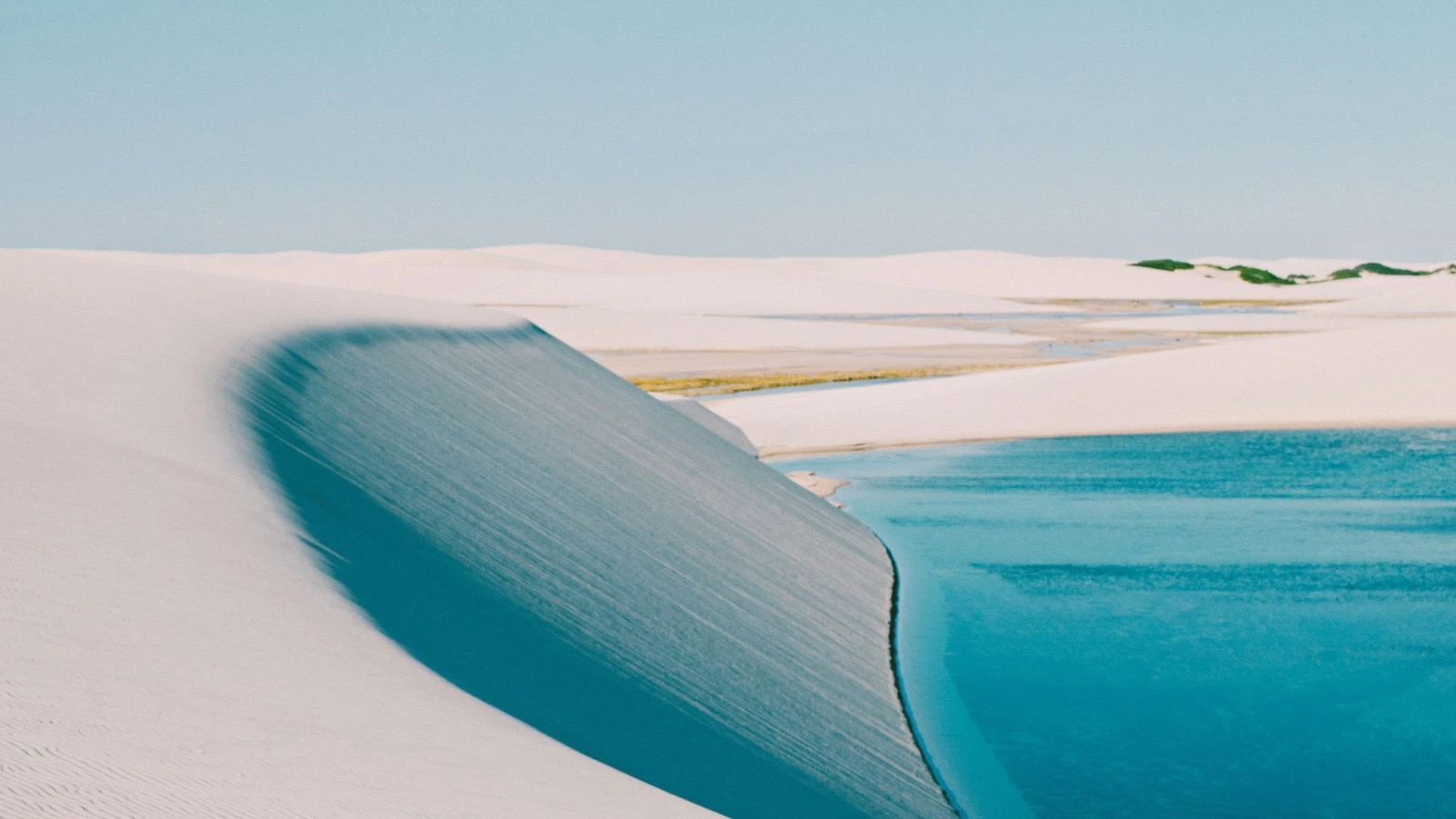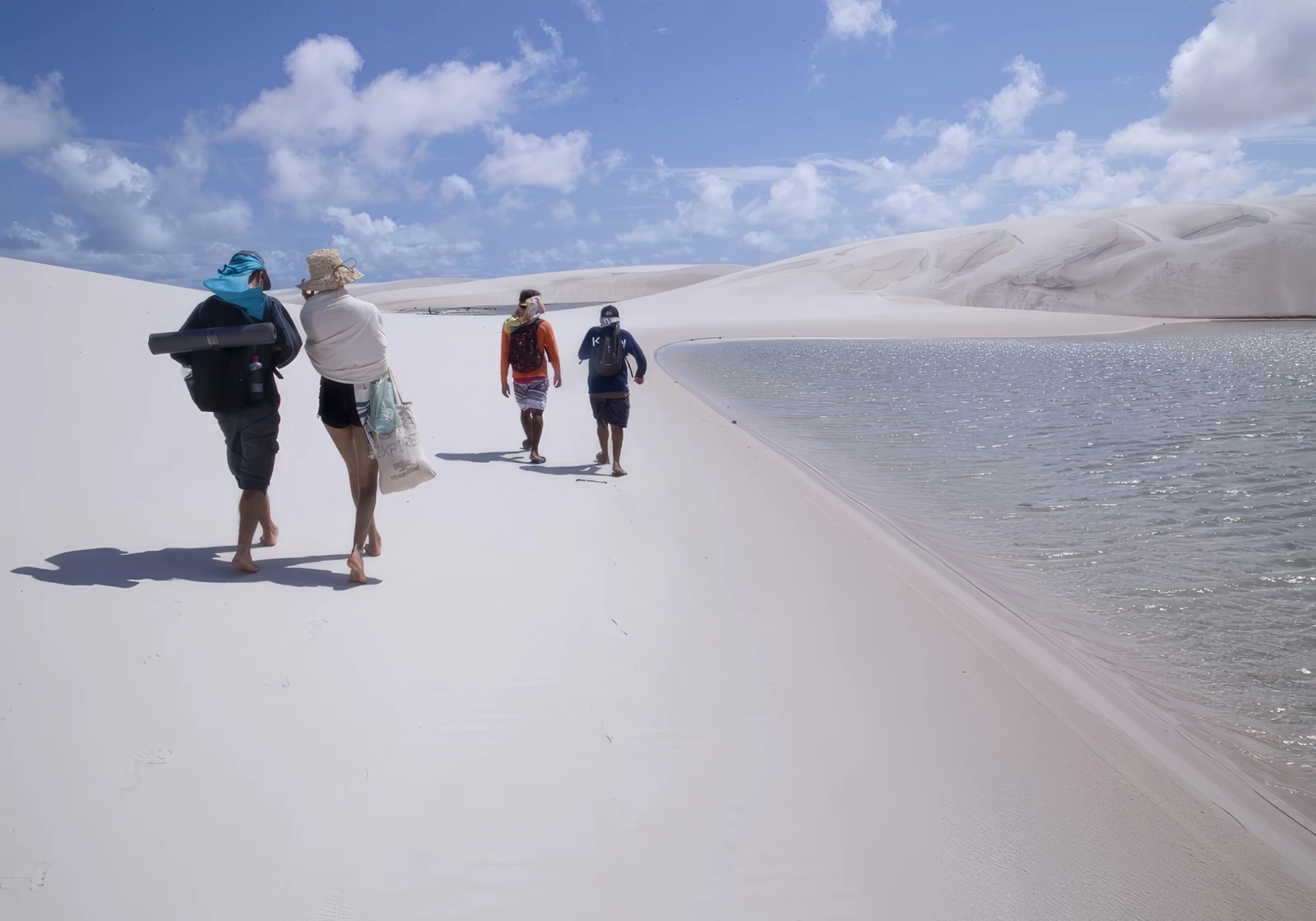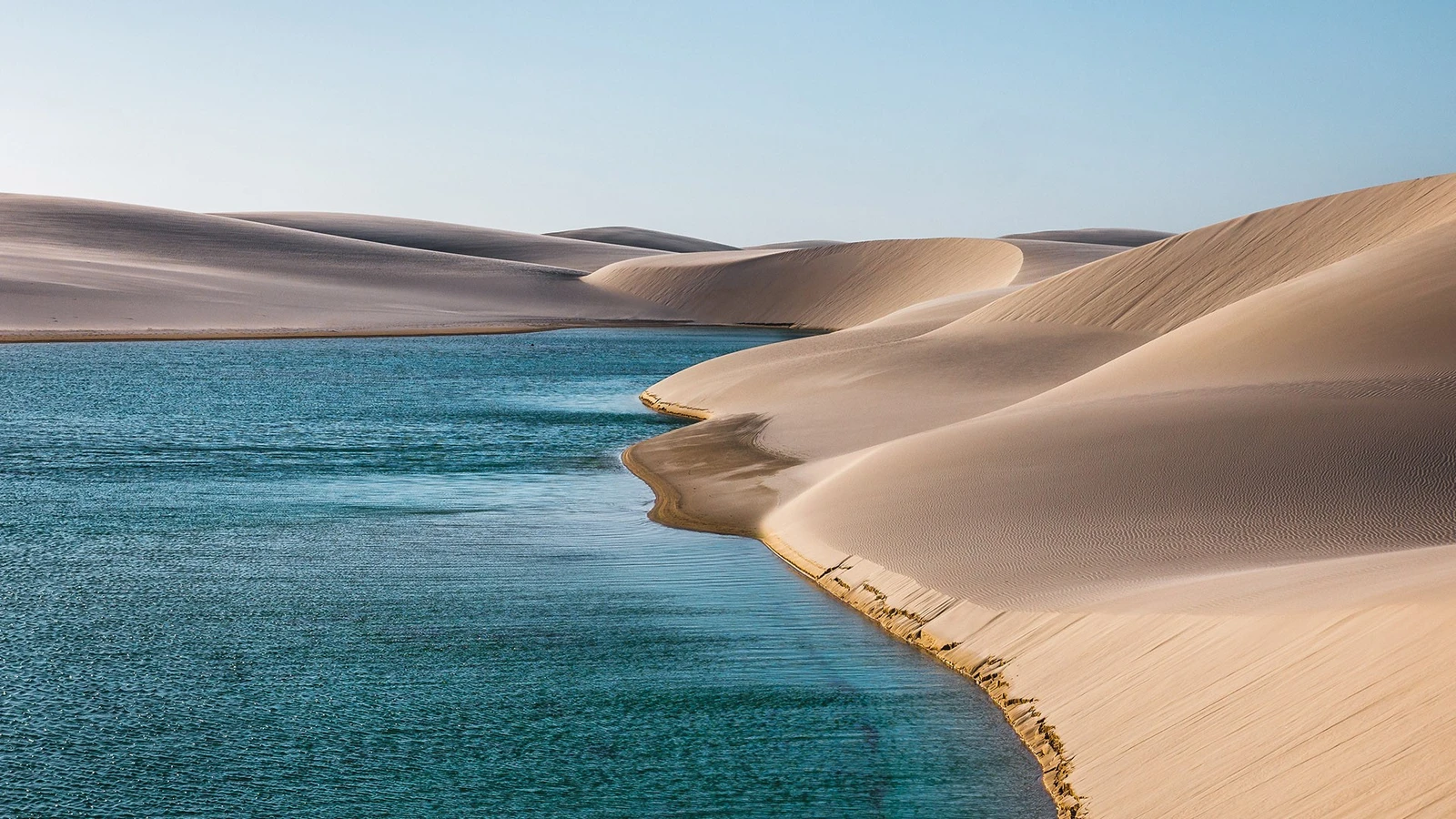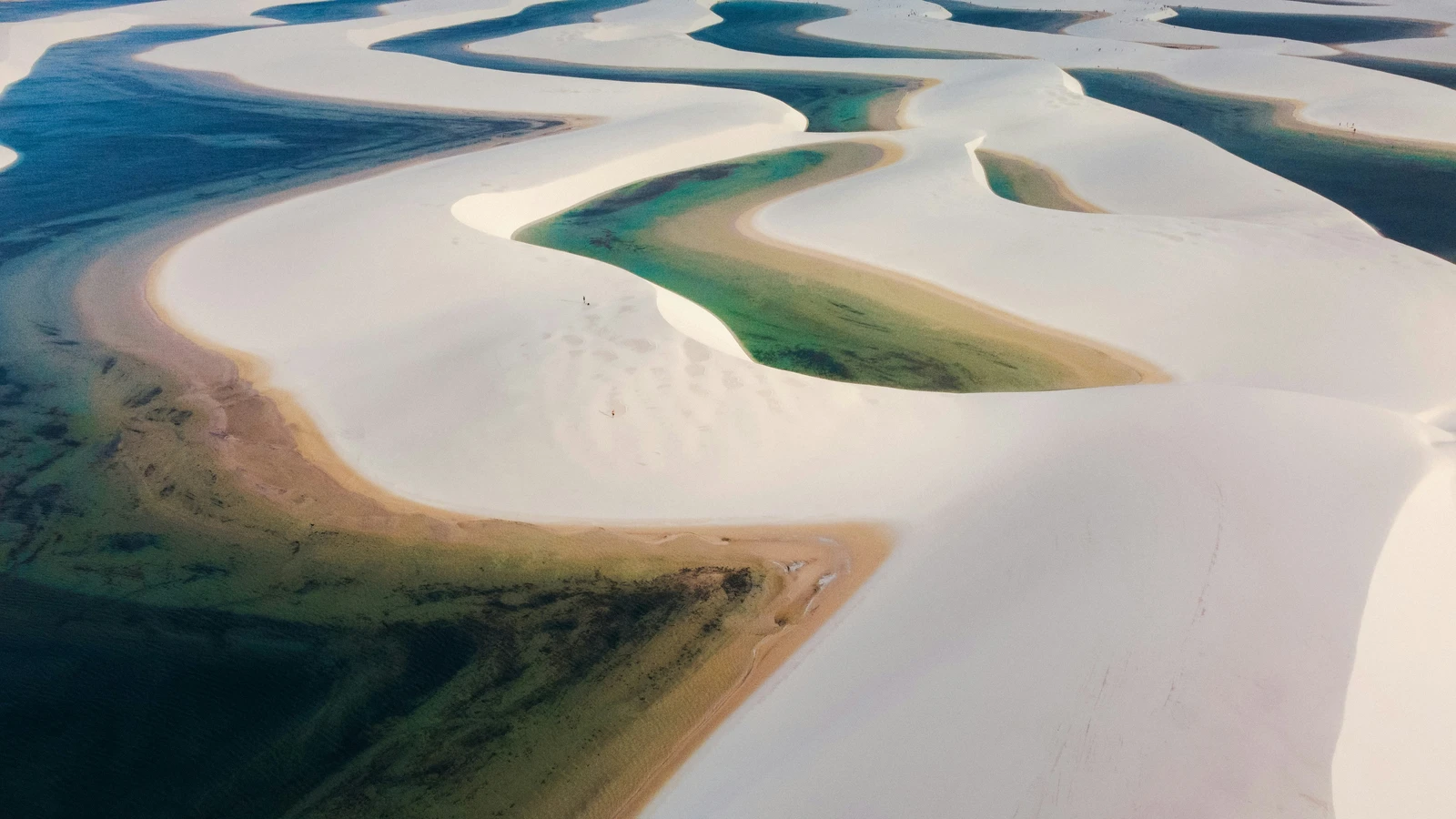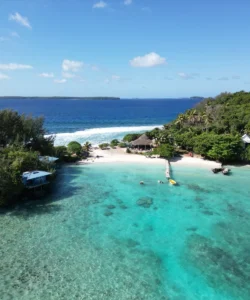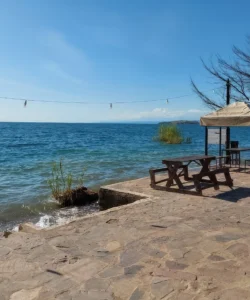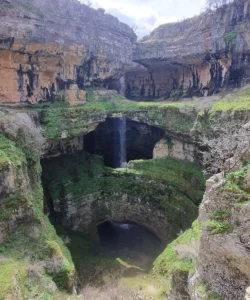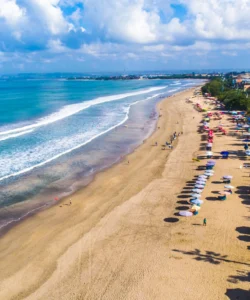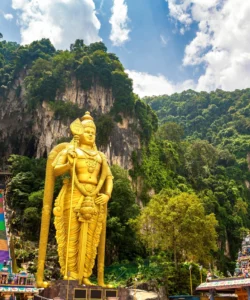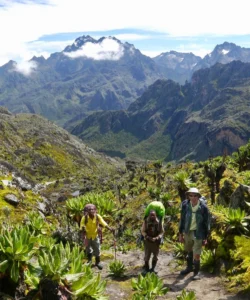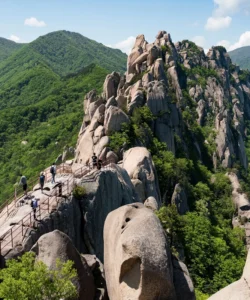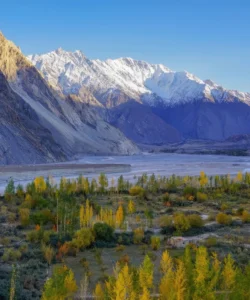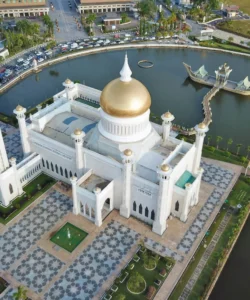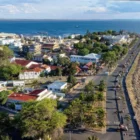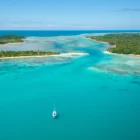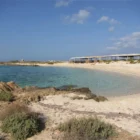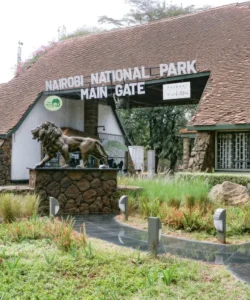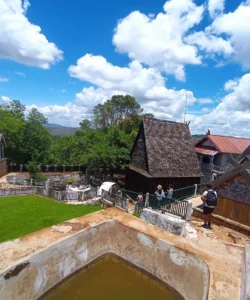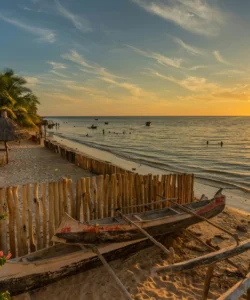Lençóis Maranhenses National Park (Parque Nacional dos Lençóis Maranhenses) is an utterly surreal and breathtaking natural wonder located on the northeastern coast of Brazil, in the state of Maranhão. Despite its desert-like appearance of vast white sand dunes, it is paradoxically not a desert. Instead, it’s a unique ecosystem where heavy seasonal rainfall creates thousands of crystal-clear freshwater lagoons nestled between rolling dunes, creating a constantly shifting, ethereal landscape. A UNESCO World Heritage site, Lençóis Maranhenses is a testament to the powerful and artistic interplay of wind, sand, and water, offering an unparalleled visual spectacle.
Listen to an introduction about Lencois Maranhenses National Park

Name: Lençóis Maranhenses National Park (Parque Nacional dos Lençóis Maranhenses). “Lençóis” means “bedsheets” in Portuguese, aptly describing the vast, crumpled white dunes seen from above.
Address: The park is accessible via three main gateway towns: Barreirinhas, Santo Amaro do Maranhão, and Atins, all in Maranhão state, Brazil.
How to get there:
Reaching Lençóis Maranhenses, involves a very long international journey to South America, followed by domestic travel within Brazil, and then specific local transfers:
- From São Luís to a Gateway Town (Barreirinhas, Santo Amaro, or Atins):
- By Shared Van/Private Transfer: This is a very common and convenient option. Vans and private cars operate daily from São Luís directly to Barreirinhas (approx. 4-5 hours) or Santo Amaro (approx. 4 hours, with the last 36km on a sandy road requiring a 4×4).
- By Bus: Daily bus services are available from São Luís bus station to Barreirinhas, taking around 5 hours.
- By Domestic Flight: Azul Airlines offers weekly flights (3 times a week) from São Luís to Barreirinhas Municipal Airport (BRB), offering incredible aerial views.
- To Atins: From Barreirinhas, Atins is typically reached by boat along the Preguiças River or by 4×4 vehicle.
- From Gateway Town into the Park:
- Once in Barreirinhas, Santo Amaro, or Atins, access to the park’s core dune and lagoon areas is typically via guided 4×4 tours. Vehicles (often large, open-sided jeeps) are the primary way to navigate the sandy terrain.
- Boat tours along the Preguiças River are also popular from Barreirinhas, allowing access to parts of the park and nearby mangroves.
- Overflights by small plane or helicopter from Barreirinhas or Santo Amaro offer breathtaking panoramic views of the entire park, truly revealing its “bedsheet” appearance.
Best Time to Visit:
The best time to visit Lençóis Maranhenses National Park is from May to September. This period offers the most iconic experience as it is after the rainy season (January to May), meaning:
- Lagoons are at their fullest: The freshwater lagoons reach their maximum water levels, making them perfect for swimming and creating the most stunning contrasts of blue/green water against the white dunes.
- Weather is generally stable: Less rain, allowing for clearer skies and better photography.
- Optimal for swimming: The water in the lagoons is crystal clear and pleasantly warm.
As the dry season progresses (from October to December), the lagoons gradually dry up. From November to January, many temporary lagoons are completely dry, revealing meadows on the lagoon floors. While still beautiful, the iconic “dunes with lagoons” landscape is less prominent during this very dry period.
Landscape and Architecture:
Lençóis Maranhenses National Park’s “architecture” is a dynamic and ethereal natural landscape, constantly reshaped by the elements:
- Vast White Sand Dunes: The dominant feature is the expansive field of pristine white sand dunes, covering about 90,000 hectares (over two-thirds of the park). These dunes can reach up to 40 meters (130 feet) in height and shift constantly due to unidirectional winds, creating a perpetually changing landscape.
- Freshwater Inter-dunal Lagoons: The most striking characteristic is the presence of thousands of temporary freshwater lagoons that form in the valleys between the dunes during and after the rainy season. These lagoons, fed exclusively by rainwater and prevented from draining by an impermeable rock layer beneath the sand, display a mesmerizing range of colors (blue, green, turquoise, black) depending on their depth and the minerals present. They are incredibly clear and perfect for swimming.
- River Channels: Permanent rivers, like the Rio Negro, run through parts of the park, and “nomadic gueltas” (water holes) form in various places with each water cycle.
- Coastal Features: The park borders about 70 kilometers (43 miles) of Atlantic coastline, featuring beaches and coastal vegetation (Restinga formations) and mangroves.
- Ecological Transition Zone: The park is located in a unique transition zone between three major Brazilian biomes: the Cerrado (savanna), the Caatinga (semi-arid), and the Amazon Rainforest. This influences its diverse vegetation in the non-dune areas.
- Lack of Permanent Human Structures (within the core dunes): The core dune field is largely untouched by permanent human “architecture,” emphasizing its raw, natural beauty. Basic tourism infrastructure (like viewing points and simple refreshment stops) is generally at the edges.
- Small Oases/Villages: Within the park, some remote oases with perennial lagoons and small, traditional fishing villages (e.g., Baixa Grande, Queimada dos Britos) exist, often reached by multi-day treks, showcasing human adaptation to this unique environment.
What makes it famous:
Lençóis Maranhenses National Park is famous for:
- “Desert with Lakes” Paradox: It defies the definition of a true desert by receiving high rainfall, which, combined with its impermeable bedrock, creates a unique phenomenon of freshwater lagoons within a vast dune field. This paradoxical landscape is globally unique.
- Stunning Visual Contrast: The breathtaking contrast between the pure white, constantly shifting sand dunes and the vivid blue, green, and turquoise freshwater lagoons is incredibly photogenic and visually arresting.
- Swimming in Desert Lagoons: The unparalleled experience of being able to swim in warm, crystal-clear freshwater lagoons located amidst what appears to be an endless desert is its signature activity and a truly surreal experience.
- UNESCO World Heritage Site: Inscribed in 2024 for its outstanding universal value, particularly its exceptional natural phenomenon and ongoing geological processes.
- Constantly Changing Landscape: The dynamic nature of the dunes and the ephemeral lagoons mean that the landscape is never exactly the same, offering a new experience with each visit.
- Otherworldly Beauty: Its surreal, almost lunar landscape has earned it a reputation as an “unreal paradise” and a backdrop for major film productions (e.g., scenes from Avengers: Infinity War were filmed here).
- Kitesurfing: Thanks to strong, consistent winds, it’s also gaining fame as one of Brazil’s best kitesurfing routes.
Differences from some other wonders:
Lençóis Maranhenses National Park distinguishes itself from other famous deserts, wetlands, or natural wonders in several profound ways:
- Rain-Fed Freshwater Lagoons in a Dune Field: While other places have sand dunes (e.g., Sahara, Gobi) or wetlands (e.g., Pantanal), Lençóis Maranhenses is unique for its annual formation of thousands of freshwater lagoons between its white sand dunes, directly from rainwater, atop an impermeable layer. This is a specific hydrological and geological phenomenon not seen elsewhere on such a scale.
- Not a True Desert: Unlike true deserts like the Sahara or Gobi, which receive very little rainfall (under 250mm/year), Lençóis Maranhenses receives significant rainfall (1,200-1,700mm/year). This makes it a “wet desert” or “pseudo-desert,” fundamentally different ecologically from other arid regions.
- Seasonal Transformation as the Main Attraction: The park’s iconic beauty is almost entirely dependent on its dramatic seasonal transformation, from dry, shifting dunes to a landscape of glistening lakes. This active, cyclical change is what defines the optimal visitor experience, unlike more static natural wonders.
- Visibility of Geological Process: It offers a clear, visual example of how wind (shaping dunes), water (filling lagoons), and underlying geology (impermeable layer) combine to create a unique and dynamic ecosystem, illustrating natural processes in a highly accessible way.
- Unique Aquatic Life in Temporary Ponds: The presence of adapted species (like the wolf fish that burrows into mud during dry periods) in these temporary freshwater lagoons highlights a unique biological adaptation to its ephemeral water sources, a distinct ecological feature.
In essence, Lençóis Maranhenses National Park is an extraordinary and breathtaking wonder, a paradoxical landscape where a “desert” becomes a temporary oasis of freshwater lakes, offering an unparalleled and immersive experience of nature’s artistry and resilience.

